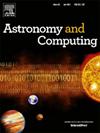Cosmological implications and stability of f(Q,T) gravity with pilgrim dark energy model
IF 1.8
4区 物理与天体物理
Q2 ASTRONOMY & ASTROPHYSICS
引用次数: 0
Abstract
This manuscript endeavors to construct a pilgrim dark energy framework within the gravity theory, employing a correspondence approach aligned with a non-interacting model that incorporates pressureless matter alongside a power-law scale factor. Here and represent the non-metricity and trace of the energy–momentum tensor, respectively. This extended modified gravity framework accurately replicates various epochs in the cosmological history. The gravity models are utilized to derive the equation of state parameter, phase planes and squared speed of sound. The analysis reveals that the reconstructed model exhibits an increasing or decreasing trend with the pilgrim dark energy parameter. The equation of state parameter characterizes the phantom regime, while the squared speed of sound parameter provides a stable framework for examining the ongoing cosmic evolution. The plane trajectories reveal the freezing region, while the phase plane shows the Chaplygin gas model. It is important to highlight that our findings align with the most recent observational data.
朝圣者暗能量模型f(Q,T)引力的宇宙学意义和稳定性
本文试图在f(Q,T)引力理论中构建一个朝圣者暗能量框架,采用与非相互作用模型相一致的对应方法,该模型将无压物质与幂律比例因子结合在一起。这里Q和T分别表示能量动量张量的非度规性和迹。这个扩展修正的引力框架精确地复制了宇宙学历史上的各个时代。利用f(Q,T)重力模型推导了状态参数、相平面和声速平方的方程。分析表明,重建模型随朝圣者暗能量参数的增大或减小而增大。状态参数方程表征了幽灵状态,而声速参数的平方为研究正在进行的宇宙演化提供了一个稳定的框架。ωDE - ωDE平面轨迹显示冻结区,而r - s相平面显示Chaplygin气体模型。重要的是要强调我们的发现与最近的观测数据是一致的。
本文章由计算机程序翻译,如有差异,请以英文原文为准。
求助全文
约1分钟内获得全文
求助全文
来源期刊

Astronomy and Computing
ASTRONOMY & ASTROPHYSICSCOMPUTER SCIENCE,-COMPUTER SCIENCE, INTERDISCIPLINARY APPLICATIONS
CiteScore
4.10
自引率
8.00%
发文量
67
期刊介绍:
Astronomy and Computing is a peer-reviewed journal that focuses on the broad area between astronomy, computer science and information technology. The journal aims to publish the work of scientists and (software) engineers in all aspects of astronomical computing, including the collection, analysis, reduction, visualisation, preservation and dissemination of data, and the development of astronomical software and simulations. The journal covers applications for academic computer science techniques to astronomy, as well as novel applications of information technologies within astronomy.
 求助内容:
求助内容: 应助结果提醒方式:
应助结果提醒方式:


